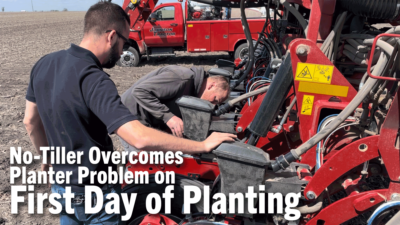While no-till was pioneered here in the states, our conversion has been gradual when compared with a few other countries.
For instance, Argentina had 48.7 million no-tilled acres in 2013, which represented an astounding 93% of that country’s crop production. Brazil had 78.6 million acres of no-till, producing 23% more soybeans than the U.S., with most double-cropped behind wheat.
Back in 2013, the worldwide no-till acreage stood at 388 million acres, with the U.S. having 88 million acres. At that time, 60% of South America’s cropland was no-tilled compared to only 24% of the ground in North America.
Creating A Monster. “No-till was born here, yet if you look at other countries, we’re falling behind,” says Bill Richards, the long-term no-tiller from Circleville, Ohio, and former Chief of the Soil Conservation Service (now NRCS) in the 1980s.
“In some ways, we have unleashed a monster in teaching the world to no-till. It has brought millions and millions of fragile acres into successful production that normally wouldn’t be row cropped. We have expanded our competitor’s capacity to produce.”
Much of the rapid no-till adoption in South America goes back to what these growers learned from U.S. agronomists who made numerous trips to Brazil and Argentina in the 1970s and 1980s.
Right from the beginning, South American growers emphasized saving dollars while harvesting higher yields rather than trying to sell no-till based on soil loss or protecting the environment. They saw no-till as a way to not only increase productivity, but also to build profitability in a sustainable manner while repairing the excessive soil damage of the past.
Back in the late 1960s and early 1970s, growers were tilling fields up to seven times. By the late 1960s, Richards was making only one pass and was able to grow 1,000 acres of corn with only one helper.
“We had proved we could do it and we were off and running with no-till,” he says.
Residue Matters. Over the years, Richards learned residue was what really made no-till work. He credits residue with covering the soil, preventing erosion and providing the organic matter required to keep the soil healthy.
He says no-till revolutionized the way North American growers farm and those using no-till long-term are really benefitting. By adding cover crops, growers see even more benefits.
“While no-till is not the only conservation practice, it is the easiest and the best and the fastest way to raise productivity and make row-crop production much more efficient,” he says. “We’ve been taught that farming is all about yields, but it is really about how much money you have left over at the end of the year that really counts.
“No-tillers benefit long-term and land owners also really benefit from the soil improvement from no-till.”







Post a comment
Report Abusive Comment